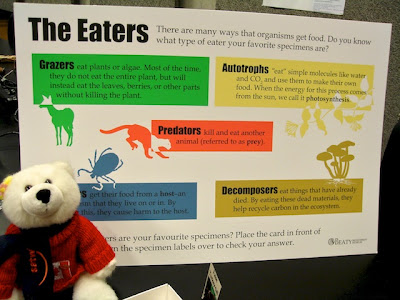When I went fishing recently off Swiftsure Bank, I learned
that humpback whales there often feed on krill.
Krill are tiny crustaceans, at most five centimetres long,
that gather in huge swarms … and
provide tasty eating for predators (animals
who kill and eat other animals) ranging from fish to birds to whales.
I can’t say these krill look delicious. Please pass me a
bowl of deep-fried shrimp with cocktail sauce, thank you.
Still, big whales know nutritious food when they see it.
Humpback whales are a kind of baleen whale: instead of teeth,
they have huge sheets of bristles, or
baleen, that let them feed by filtering seawater.
A humpback whale takes in big mouthfuls of seawater full of
krill, herring, or other tiny prey, then pushes the water back out through its
baleen plates.
What’s the whale left with? A mouthful of seafood!
That mouthful of seafood can have something like half a million calories. This is such an
efficient way of eating that baleen whales have been able to evolve to enormous
size. And I saw just how enormous at
the University of British Columbia’s Beaty Biodiversity Museum.
The Beaty Biodiversity is a natural history museum that
celebrates life’s amazing variety, evolution, and interconnection. It has about
two million specimens in over 1,800 square metres of exhibits.
The museum is on the University of British Columbia’s Point
Grey campus, about 10 kilometres from downtown Vancouver. UBC’s 400-hectare
main campus welcomes over 47,000 students every year.
There are several
beautiful museums on campus: the Museum of Anthropology, UBC Botanical Garden,
Pacific Museum of the Earth, Chung Collection, Morris and Helen Belkin Art Gallery, and more. The Beaty is the newest; it opened in October of 2010.
My jaw dropped as soon as I walked into the Beaty ... and so
will yours.
This is a 26-metre-long blue
whale, the largest on display in Canada. There are only twenty other blue
whale skeletons on display around the whole world.
Whales are warm-blooded, air-breathing mammals just like you
and me. They evolved from a four-legged, land-dwelling ancestor that re-adapted
to the sea beginning about 50 million years ago.
Look at the bones in the blue whale’s fin – you wouldn’t
guess it from the outside, but the fin has bones similar to your hand or my
paw.
Like humpbacks, blue whales are baleen whales. They can grow
up to 30 metres long, and weigh as much as 150 tons. Blue whales are the
biggest animals that have ever lived on our planet. Take that, Apatosaurus!
Blue whales need to eat three or four tons of krill every
day (that’s about forty million krill).
Female blue whales grow bigger than males. Yup, that means
that the largest animals ever known to have lived on Earth are girls! Their babies are big too: a
newborn blue whale is nearly eight metres long, and drinks over 350 litres of
mother’s milk every darn day. Burp.
The Beaty’s blue whale was a girl. Her 80,000-kilogram body
washed ashore near Tignish, Prince Edward Island, in 1987. The provincial
government and the Canadian Museum of Nature carefully buried her body to
preserve it for science. Twenty years later, UBC got the okay to bring the
skeleton to Vancouver. What a big job!
Sabrina is one of the Beaty’s guides. Here she is holding a
cougar’s skull.
Sabrina showed me around the cabinets of displays next to
the blue whale’s skeleton. About 95% of the Beaty’s collections are in cabinets
in the public galleries.
There are galleries about mammals, birds, amphibians, and
reptiles (the Cowan Tetrapod Collection),
plants and fungi (the Herbarium),
insects (the Spencer Entomological
Collection), fish (the Fish Museum),
shellfish, worms, and other creatures without spinal columns (the Marine Invertebrate Collection), and
fossils (the Fossil Collection).
Look how this cougar, a carnivore
(meat-eater) has really sharp teeth. The skull beside it has the flat teeth of
a herbivore, or plant-eater:
These are the skulls of bears. Most bears are omnivores
(we eat plants or meat … and personally,
I quite like dessert, too). My polar bear
friends are carnivores, though, while panda
bears are strictly vegetarian.
Look – here are photos at the Beaty of some of my Spirit Bear kin back home!
These are the jaws of a shark.
Sharks never run out of teeth: if one falls out, a new one moves in from
behind. Can you see the rows of teeth waiting to move in?
The Beaty’s Discovery
Lab lets you take a closer look at many specimens.
The museum also has neat programmes happening all during the
day: story times, puppet shows, crafts and special activities, tours, films,
and lectures.
This summer, “To Eat or Be Eaten” is a special theme. Before
visiting the Beaty, I hadn’t actually thought of baleen whales as predators – more like just easy-going snackers
– but I realize now that they are. The krill certainly must think so!
Story © S. Clouthier
Videos courtesy Apexpredator11, BBCWorldwide
Videos courtesy Apexpredator11, BBCWorldwide
Photo of baleen courtesy Randall Wade Grant / Flickr
Other photos © S. Clouthier and D. Wei


























No comments:
Post a Comment